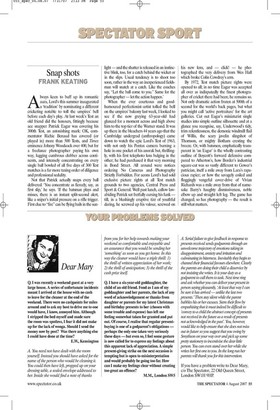Snap shots
FRANK KEATING Always keen to buff up its romantic aura, Lord's this summer inaugurated a 'tradition' by nominating a different cricketing notable to toll the umpires' bell before each day's play. At last week's Test an old friend did the honours, fittingly because ace snapper Patrick Eagar was covering his 300th Test, an astonishing mark: OK, commentator Richie Benaud has covered (or played in) more than 500 Tests, and Times eminence Johnny Woodcock over 400, but for a freelance photographer paying his own way, lugging cumbrous clobber across continents, and intensely concentrating on every single ball bowled of all five days of 300 Test matches is a far more taxing order of diligence and professional sedulity.
Not that Patrick actually snaps every ball delivered. 'You concentrate as fiercely, say, as first slip,' he says. 'If the batsman plays and misses, there is an instant split-second alert, like a sniper's initial pressure on a rifle trigger. First clue to "fire" can be flying bails in the sunlight — and the shutter is released in an instinctive blink, too, for a catch behind the wicket or in the slips. Usual tendency is to shoot too soon, rather in the way an inexperienced fieldsman will snatch at a catch. Like the coaches say, "Let the ball come to you." Same for the photographer — let the action happen.'
When the ever courteous and goodhumoured perfectionist–artist tolled the bell on the umpires' balcony last week, I looked to see if the now greying 63-year-old had glanced for a moment across and high above him to the top tier of the Warner stand. It was up there in the bleachers 44 years ago that the Cambridge undergrad (anthropology) came down to watch the epic Lord's Test of 1963, with not only his Pentax camera burning a hole in one pocket of his anorak but, thrillingly, with his first telephoto lens bulging in the other; he had purchased it that very morning in Bond Street. All around were notices ordering No Cameras and Photography Strictly Forbidden. For aeons Lord's had sold exclusive picture rights at all Test match grounds to two agencies, Central Press and Sport & General. Well past lunch, callow lawabiding Patrick sat fretfully cursing his funk — till, in a blushingly eruptive tizz of youthful daring, he screwed up his valour, screwed on his new lens, and — click! — he photographed the very delivery from Wes Hall which broke Colin Cowdrey's arm.
By 1972, Test match picture rights were opened to all; in no time Eagar was accepted all over as indisputedly the finest photographer of cricket there had been; he remains so Not only dramatic action frozen at 500th of a second for the world's back pages, but what you might call 'active portraiture' for the art galleries. Cut out Eagar's miniaturist single studies into simple outline silhouette and at a glance you recognise, say, Underwood's tidy, trim relentlessness, the demonic windmill flail of Willis, the scary javelin slingshot of Thomson, or mighty Botham cresting the breeze. Or, with batsmen, emphatically transparent in 'an Eagar' is the wholly contrasting outline of Boycott's forward defensive compared to Atherton's, how Border's industrial square-cut was so vastly different to Gower's patrician, itself a mile away from Lara's rapacious rapier; or how the savagely coiled and floggingly vengeful cover-drive of Vivian Richards was a mile away from that of namesake Barry's haughty dismissiveness, noble elbow up and straight left leg. The game has changed; so has photography — the result is still what matters.








































 Previous page
Previous page